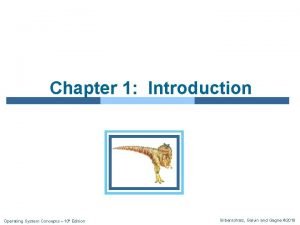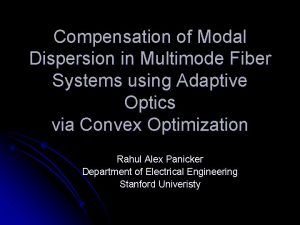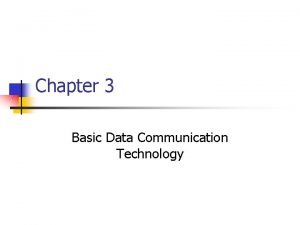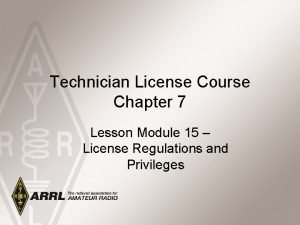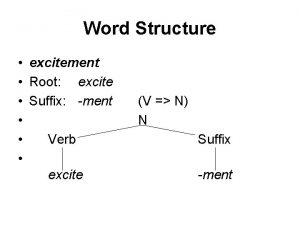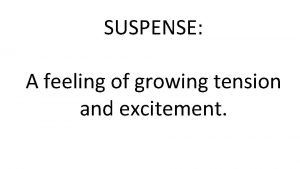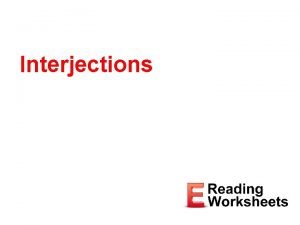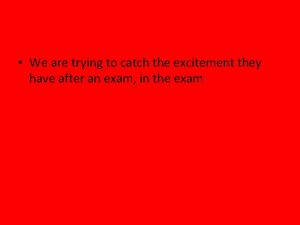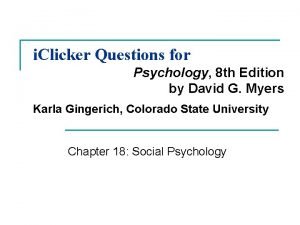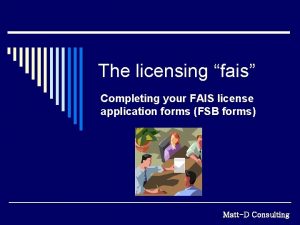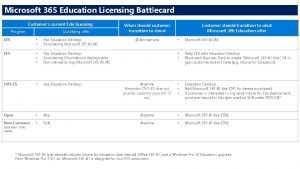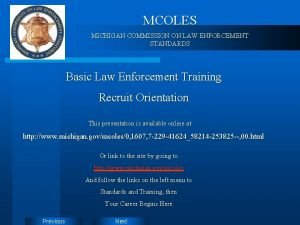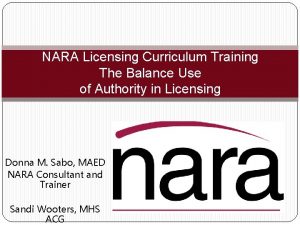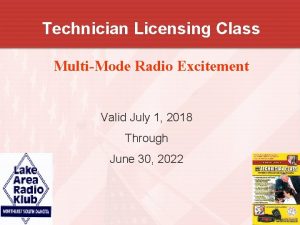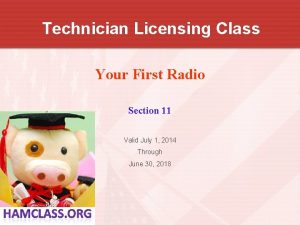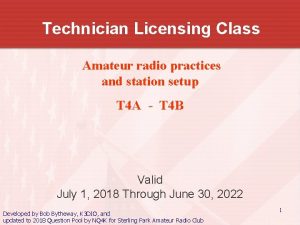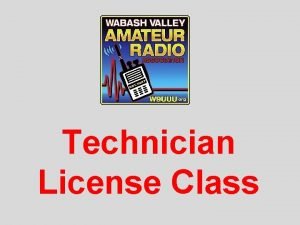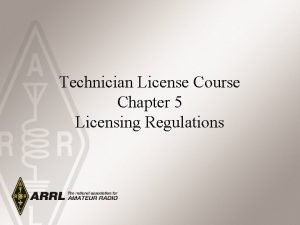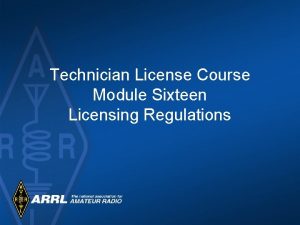Technician Licensing Class MultiMode Radio Excitement Section 6















































- Slides: 47

Technician Licensing Class Multi-Mode Radio Excitement Section 6 Valid July 1, 2014 Through June 30, 2018

Multi-Mode Radio Excitement A “transceiver” combines both transmitting and receiving functions in one package • T 7 A 02 • T 7 A 09 A multi-mode VHF transceiver is most useful for VHF weak -signal communication.

Multi-Mode Radio Excitement Modulation is the process of applying information (voice, video, or digital) onto a radio signal T 7 A 08

Multi-Mode Radio Excitement 4

Multi-Mode Radio Excitement T 8 A 01 Single sideband is a form of amplitude modulation. Carrier only CW • Tones produce both side bands or AM Remove one sideband suppress carrier becomes SSB Single Sideband (SSB) is the type of voice mode is most often used for long-distance (weak signal) contacts on the VHF and UHF bands. T 8 A 03

Multi-Mode Radio Excitement • The primary advantage of single sideband over FM for voice transmissions is that SSB signals have narrower bandwidth • 3 k. Hz is the approximate bandwidth of a single sideband voice signal. • For single sideband -- 2400 Hz would be the appropriate receive filter to minimize noise and interference • The upper sideband is normally used for 10 meter HF, VHF and UHF single-sideband communications T 8 A 07 T 8 A 08 T 4 B 09 T 8 A 06

Multi-Mode Radio Excitement • • • The use of SSB phone is permitted in at least some portion of all the amateur bands above 50 MHz T 4 B 06 The receiver RIT or clarifier controls could be used if the voice pitch of a single-sideband signal seems too high or low. T 2 B 13 T 4 B 7 The term "RIT" means Receiver Incremental Tuning. Set knob to neutral, press RIT button to turn on function, and then adjust slightly for proper SSB voice reception RIT adjusts voice pitch, not the frequency of received station.

Multi-Mode Radio Excitement • T 4 A 1 • Some microphone connectors on amateur transceivers include push-to-talk functions and voltage links for powering the microphone. An oscillator is a circuit that generates a signal of a desired frequency. T 7 A 05

Multi-Mode Radio Excitement CW (Continuous Wave or Morse Code) is the type of emission that has the narrowest bandwidth. • T 8 A 05 • T 8 A 11 150 Hz is the approximate maximum bandwidth required to transmit a CW signal. CW Signal 150 Hz wide SSB Signal 2 - 3 k. Hz wide FM Signal 5 - 15 k. Hz wide UHF Fast-Scan TV ~ 6 MHz

Multi-Mode Radio Excitement • 500 Hz is an appropriate receive filter to select in order to minimize noise and interference for CW reception. T 4 B 10 • Bandwidth filters vary for the mode being received. • The advantage of having multiple receive bandwidth choices on a multimode transceiver will permit noise or interference reduction by selecting a bandwidth matching the mode. T 4 B 08

Multi-Mode Radio Excitement • The function of a mixer is to convert a radio signal from one frequency to another. T 7 A 03 Station Signal MIXER Signal A at 800 k. Hz (or at 1200 k. Hz) Signal C at 455 k. Hz (In AM Broadcast Receiver) Intermediate Frequency Local Oscillator Signal B at 1255 k. Hz (or at 1655 k. Hz) Block Diagram of an AM Broadcast Receiver Mixer

Multi-Mode Radio Excitement • T 7 A 04 Selectivity is the term that describes the ability of a receiver to • T 7 A 01 Sensitivity is the ability of a receiver to detect the presence of • T 4 B 12 AGC or automatic gain control is used to keep discriminate between multiple signals. a signal. received audio relatively constant. An RF pre-amp is installed between the antenna input and the receiver. • T 7 A 11

Multi-Mode Excitement • A transverter is a device that takes the output of a lowpowered 28 MHz SSB exciter and produces a 222 MHz output signal. T 7 A 06

Your First Radio Preventing voltage fluctuations from reaching sensitive circuits is a good reason to use a regulated power supply for communications equipment. T 4 A 03 MFJ-4125 13. 8 VDC@22 Amp Jetstream JTPS 30 M Regulated Power Supply

Take Aways

Take Aways A “transceiver” combines both transmitting and receiving functions in one package A multi-mode VHF transceiver is most useful for VHF weak‑signal communication. Modulation is the process of applying information (voice, video, or digital) onto a radio signal Single sideband is a form of amplitude modulation Single Sideband (SSB) is the type of voice mode is most often used for long-distance (weak signal) contacts on the VHF and UHF bands.

Take Aways The primary advantage of single sideband over FM for voice transmissions is that SSB signals have narrower bandwidth 3 k. Hz is the approximate bandwidth of a single sideband voice signal. (3 k. Hz equals 3000 Hz) For single sideband 2400 Hz would be the appropriate receive filter to minimize noise and interference The upper sideband is normally used for 10 meter HF, all VHF and all UHF single-sideband communications

Take Aways The use of SSB phone is permitted in at least some portion of all the amateur bands above 50 MHz The receiver RIT or clarifier controls could be used if the voice pitch of a single-sideband signal seems too high or low. The term "RIT" means Receiver Incremental Tuning. • Some microphone connectors on amateur transceivers include push-to -talk functions and voltage links for powering the microphone. • An oscillator is a circuit that generates a signal of a desired frequency.

Take Aways In comparison to SSB and FM, CW emission has the narrowest bandwidth. The approximate maximum bandwidth to transmit a CW signal is 150 Hz An appropriate receive filter used in order to minimize noise and interference for CW reception is 500 Hz. The advantage of having multiple receive bandwidth choices on a multimode transceiver permits noise or interference reduction by selecting a bandwidth matching the mode.

Take Aways The function of a mixer is to convert a radio signal from one frequency to another Selectivity is the term that describes the ability of a receiver to discriminate between multiple signals. Sensitivity is the ability of a receiver to detect the resence of a signal. AGC or automatic gain control is used to keep received audio relatively constant. An RF pre-amp is installed between the antenna input and the receiver.

Take Aways A transverter is a device that takes the output of a low-powered 28 MHz SSB exciter and produces a 222 MHz output signal. Preventing voltage fluctuations from reaching sensitive circuits is a good reason to use a regulated power supply for communications equipment.

Element 2 Technician Class Question Pool Multi-Mode Radio Excitement Valid July 1, 2014 Through June 30, 2018

T 7 A 02 What is a transceiver? A. A type of antenna switch B. A unit combining the functions of a transmitter and receiver C. A component in a repeater which filters out unwanted interference D. A type of antenna matching network 23

T 7 A 09 Which of the following devices is most useful for VHF weak-signal communication? A. B. C. D. A quarter-wave vertical antenna A multi-mode VHF transceiver An omni-directional antenna A mobile VHF FM transceiver 24

T 8 A 03 Which type of voice mode is most often used for long-distance (weak signal) contacts on the VHF and UHF bands ? A. B. C. D. FM DRM SSB PM 25

T 8 A 07 What is the primary advantage of single sideband over FM for voice transmissions? A. B. C. D. SSB signals are easier to tune SSB signals are less susceptible to interference SSB signals have narrower bandwidth All of these choices are correct 26

T 8 A 01 Which of the following is a form of amplitude modulation? A. B. C. D. Spread-spectrum Packet radio Single sideband Phase shift keying 27

T 8 A 06 Which sideband is normally used for 10 meter HF, VHF and UHF single-sideband communications? A. B. C. D. Upper sideband Lower sideband Suppressed sideband Inverted sideband 28

T 7 A 08 Which of the following describes combining speech with an RF carrier signal? A. B. C. D. Impedance matching Oscillation Modulation Low-pass filtering 29

T 8 A 08 What is the approximate bandwidth of a single sideband voice signal? A. B. C. D. 1 k. Hz 3 k. Hz 6 k. Hz 15 k. Hz 30

T 4 B 09 Which of the following is an appropriate receive filter bandwidth to select in order to minimize noise and interference for SSB reception? A. B. C. D. 500 Hz 1000 Hz 2400 Hz 5000 Hz 31

T 2 B 13 Which of the following is true of the use of SSB phone in amateur bands above 50 MHz? A. It is permitted only by holders of a General Class or higher license B. It is permitted only on repeaters C. It is permitted in at least some portion of all the amateur bands above 50 MHz D. It is permitted only on when power is limited to no more than 100 watts 32

T 4 B 06 Which of the following controls could be used if the voice pitch of a single-sideband signal seems too high or low? A. B. C. D. The AGC or limiter The bandwidth selection The tone squelch The receiver RIT or clarifier 33

T 4 B 07 What does the term "RIT" mean? A. B. C. D. Receiver Input Tone Receiver Incremental Tuning Rectifier Inverter Test Remote Input Transmitter 34

T 4 A 01 Which of the following is true concerning the microphone connectors on amateur transceivers? A. All transceivers use the same microphone connector type B. Some connectors include push-to-talk and voltages for powering the microphone C. All transceivers using the same connector type are wired identically D. Un-keyed connectors allow any microphone to be connected 35

T 7 A 05 What is the name of a circuit that generates a signal of a desired frequency? A. B. C. D. Reactance modulator Product detector Low-pass filter Oscillator 36

T 8 A 05 Which of the following types of emission has the narrowest bandwidth? A. B. C. D. FM voice SSB voice CW Slow-scan TV 37

T 8 A 11 What is the approximate maximum bandwidth required to transmit a CW signal? A. B. C. D. 2. 4 k. Hz 150 Hz 1000 Hz 15 k. Hz 38

T 4 B 10 Which of the following is an appropriate receive filter bandwidth to select in order to minimize noise and interference for CW reception? A. B. C. D. 500 Hz 1000 Hz 2400 Hz 5000 Hz 39

T 4 B 08 What is the advantage of having multiple receive bandwidth choices on a multimode transceiver? A. Permits monitoring several modes at once B. Permits noise or interference reduction by selecting a bandwidth matching the mode C. Increases the number of frequencies that can be stored in memory D. Increases the amount of offset between receive and transmit frequencies 40

T 7 A 01 Which term describes the ability of a receiver to detect the presence of a signal? A. B. C. D. Linearity Sensitivity Selectivity Total Harmonic Distortion 41

T 7 A 03 Which of the following is used to convert a radio signal from one frequency to another? A. B. C. D. Phase splitter Mixer Inverter Amplifier 42

T 7 A 04 Which term describes the ability of a receiver to discriminate between multiple signals? A. B. C. D. Discrimination ratio Sensitivity Selectivity Harmonic Distortion 43

T 4 B 12 What is the function of automatic gain control or AGC? A. B. C. D. To keep received audio relatively constant To protect an antenna from lightning To eliminate RF on the station cabling asymmetric goniometer control used for antenna matching 44

T 7 A 11 Where is an RF preamplifier installed? A. Between the antenna and the receiver B. At the output of the transmitter’s power amplifier C. Between transmitter and antenna tuner D. At the receiver’s audio output 45

T 7 A 06 What device takes the output of a low-powered 28 MHz SSB exciter and produces a 222 MHz output signal? A. B. C. D. High-pass filter Low-pass filter Transverter Phase converter 46

T 4 A 03 Which is a good reason to use a regulated power supply for communications equipment? A. It prevents voltage fluctuations from reaching sensitive circuits B. A regulated power supply has FCC approval C. A fuse or circuit breaker regulates the power D. Power consumption is independent of load 47
 Gephi multimode network projection
Gephi multimode network projection Multimode theory of attention
Multimode theory of attention Multimode operation in os
Multimode operation in os Multimode fiber modal dispersion
Multimode fiber modal dispersion Standar redaman fiber optik telkom
Standar redaman fiber optik telkom All multimode modems are not created equal
All multimode modems are not created equal Technician class privileges
Technician class privileges Trunking vs conventional radio system
Trunking vs conventional radio system Show don't tell excitement
Show don't tell excitement Suffix excite
Suffix excite Thrill, tension, excitement
Thrill, tension, excitement Show not tell the pizza was delicious
Show not tell the pizza was delicious Express excitement words
Express excitement words Simile of excitement
Simile of excitement Ironic essay
Ironic essay Catch the excitement
Catch the excitement The excitement that lingers after a frightening event
The excitement that lingers after a frightening event Mbitr radio class
Mbitr radio class Wisconsin ems licensing
Wisconsin ems licensing Veritas backup exec capacity edition lite
Veritas backup exec capacity edition lite Virginia dbhds human rights regulations
Virginia dbhds human rights regulations Fais forms
Fais forms Psu qualtrics
Psu qualtrics Qlik license types
Qlik license types Module 4 - open source software and licensing
Module 4 - open source software and licensing Microsoft education licensing
Microsoft education licensing Mcoles exit standards
Mcoles exit standards West calcasieu cameron 3767 baton rouge la 70821
West calcasieu cameron 3767 baton rouge la 70821 Licensing in sports
Licensing in sports Railway land licensing circular
Railway land licensing circular Industries requiring compulsory licensing *
Industries requiring compulsory licensing * Illinois graduated license
Illinois graduated license Utah daycare licensing
Utah daycare licensing Licensing franchising and other contractual strategies
Licensing franchising and other contractual strategies Bookstore umw
Bookstore umw Oregon piercing license
Oregon piercing license Mvls microsoft licensing
Mvls microsoft licensing Spla licensing reporting
Spla licensing reporting Nara licensing
Nara licensing School business administrator licensing
School business administrator licensing Natural health product regulations
Natural health product regulations Microsoft partner balingen
Microsoft partner balingen Export licensing requirements
Export licensing requirements Digital content licensing
Digital content licensing Georgia child care licensing regulations
Georgia child care licensing regulations Michigan department of licensing and regulatory affairs
Michigan department of licensing and regulatory affairs Entry strategy licensing
Entry strategy licensing Ibm pvu sub capacity licensing
Ibm pvu sub capacity licensing


